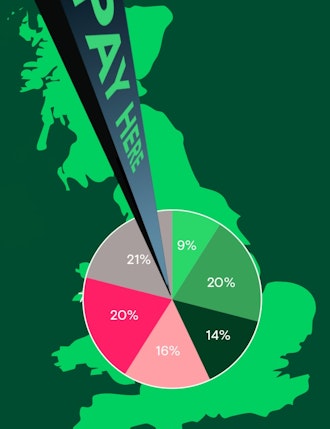Key Insights
-
VAMP updates in April will enforce stricter compliance thresholds, requiring proactive strategies from acquirers and merchants.
-
By integrating CP transactions with CNP transactions, merchants can lower their overall fraud and chargeback ratios.
-
From promoting in-person transactions to adopting omnichannel solutions, there are several best practices for acquirers to manage risks and stay compliant.
Don't have time to read more now? Sign up to our newsletter to get the latest insights directly in your inbox.
The compliance clock is ticking. April’s Visa Acquirer Monitoring Program (VAMP) update is bringing stricter fraud thresholds and tougher penalties, meaning there's now zero room for error. If you’re an acquirer or merchant, waiting until the last minute isn’t an option.
Card-not-present transactions are fraud hotspots. Higher chargeback rates and unauthorized disputes, as well as regulatory scrutiny mean they easily push merchants past VAMP thresholds. But there’s a way to rebalance the equation: card-present payments. Let's explore...
A compliance framework for acquirers and merchants
VAMP is Visa’s monitoring system designed to ensure that acquirers and merchants maintain secure and compliant transaction practices. By closely tracking fraud and chargeback ratios, Visa aims to prevent excessive disputes and penalize non-compliant entities.
VDMP and VFMP are the most important parts of the program:
- Visa Dispute Monitoring Program (VDMP): Monitors chargeback ratios and enforces penalties for excessive disputes.
- Visa Fraud Monitoring Program (VFMP): Targets merchants with high fraud rates, requiring them to take corrective action.
With the 2025 updates, VAMP will consolidate VDMP and VFMP into a single program with stricter compliance thresholds, increased penalties, and a unified metric for fraud and non-fraud disputes. These changes demand a more proactive approach to risk mitigation.
The challenge of Card-Not-Present (CNP) transactions
CNP transactions, where card details are entered online or over the phone—are inherently riskier than card-present transactions due to:
- Higher susceptibility to fraud, including chargebacks due to unauthorized transactions.
Increased first-party (friendly) fraud, where customers dispute legitimate purchases. - Greater regulatory audits, leading to more stringent fraud prevention requirements.
Given these risks, merchants processing a high volume of CNP transactions are more likely to breach VAMP thresholds, triggering penalties and operational restrictions. To counter this, incorporating card-present transactions into the payment mix is a strategic solution.
How Card-Present (CP) transactions reduce risks
CP transactions, where a physical card is used at a terminal, offer significant advantages in mitigating fraud and chargeback risks:
1. Lower fraud rates
- EMV chip technology and contactless payments enhance security by reducing counterfeit fraud.
- Real-time authentication methods, such as PIN entry and biometric verification, add an extra layer of security.
2. Reduced chargeback liability
- CP transactions benefit from stronger chargeback protections under Visa’s rules.
- Liability for fraud shifts to the issuing bank if the merchant processes transactions using EMV-compliant terminals.
3. Enhanced consumer trust and compliance
- Customers tend to have higher trust levels in physical transactions, reducing disputes.
- Merchants can more easily verify customer identities, minimizing unauthorized chargeback claims
By integrating CP transactions with CNP transactions, merchants can lower their overall fraud and chargeback ratios. A diversified transaction mix allows merchants to maintain compliance with VAMP thresholds more effectively. Also, CP transactions using digital payment methods like mobile phones or smartwatches enhance security by leveraging tokenization, biometric authentication, and encrypted data transmission.
Best practices for implementing a balanced card present payment mix
To leverage the benefits of CP transactions while continuing to process CNP payments, merchants should consider the following strategies:
- Adopt omnichannel payment solutions: Ensure customers can pay both online and in-store using integrated systems that unify transaction data.
- Encourage in-person transactions for high-risk purchases: Prioritize card-present authentication.
- Optimize fraud prevention for CNP transactions: Use tools like tokenization or AI-driven fraud detection to reduce CNP fraud risk.
Successfully managing the updated VAMP framework requires acquirers and merchants to adopt proactive and collaborative strategies. By focusing on fraud prevention, dispute management, and transparent operations, stakeholders can stay compliant while minimizing risks. Aevi provides key tools and solutions that help acquirers and their merchants navigate these challenges effectively.
“In a world of ever-increasing challenges of card fraud, we believe Visa's VAMP (Visa Acquirer Monitoring Program) is a step in the right direction. Most of today's fraudulent transactions are conducted online, card present transactions are less prone to fraud, thanks to the strong security around in-person card acceptance. For merchants with both online and in-person commerce, an omnichannel solution might be able to alleviate the overall fraud risk.”
Prasad Nambiar, Senior Solutions Consultant, Aevi
Card present payments are as much about control as they are about transactions. With Visa’s compliance updates around the corner, acquirers and merchants need a payment strategy that optimizes both card-present transactions and digital payments to reduce fraud, prevent chargebacks, and stay compliant.
Here’s how Aevi makes that happen:
- Flexible, cloud-based payment orchestration ensures secure, tokenized transactions across multiple payment methods, including card-present payments, digital wallets, and contactless transactions. Cut fraud exposure, reduce disputes, and ensure a compliant, secure payment experience.
- End-to-end monitoring of card present and card-not-present transactions, helping acquirers and merchants spot fraudulent trends early and act before chargebacks escalate.
- Smooth integration with third-party fraud solutions, ensuring a tailored fraud mitigation approach that protects card-present transactions while optimizing security for online payments.
- Total transaction data visibility. Whether it’s a card-present transaction at the terminal or a digital purchase online, merchants can respond to disputes fast with real-time, accurate payment data.
- Live compliance tracking. Stay ahead of Visa’s new thresholds with real-time reporting on card-present payments and CNP transactions, ensuring compliance with evolving fraud rules.
- One unified payment ecosystem. Acquirers and merchants collaborate easily to ensure every card-present payment and digital transaction is processed securely, and without friction.
- Seamless card-present and card-not-present payment integration. Aevi’s connected commerce solutions bring in-store and online payments together, so merchants and acquirers have full control over fraud prevention and transaction visibility.
And that’s just the start…
Balancing CP and CNP transactions isn’t just a compliance tactic, it’s a strategic approach to building a more resilient payment ecosystem. Merchants and acquirers that proactively adapt to these changes will be better positioned for sustainable growth in an increasingly regulated environment.
Don't wait for April, partner with Aevi today to navigate the updated VAMP framework effectively and position yourself for sustainable growth.
Ready to future-proof your payment strategy? Learn how Aevi can help you stay secure, compliant, and ahead of the curve.
Interested in reading more around this subject? Here are some useful articles…














